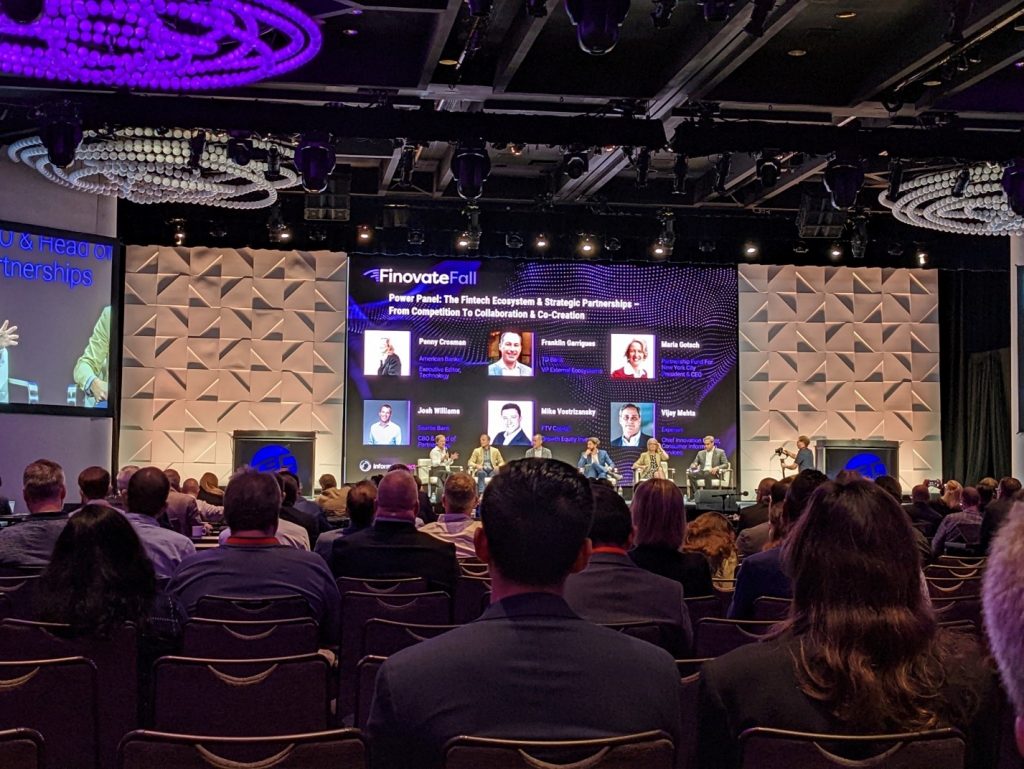FinovateFall 2022: The key to successful partnerships in financial services
The discussion surrounding competition vs collaboration between banks and fintechs has been ongoing for some time now, but with the pace of change in the industry, partnerships are now necessary for firms to keep up with new developments and ensure their digital offerings remain relevant and up to date.

A panel discussion on bank-fintech collaboration took place at this year’s FinovateFall
With more firms looking to work together to tackle the ever-evolving industry landscape, how can companies ensure they choose the right partners to boost their chances of successful collaboration?
This topic was one of many discussed at the FinovateFall conference in New York this week, with a number of industry veterans having their say.
In a panel discussion at the event, moderator and executive editor, technology at American Banker Penny Crosman got the session underway by referencing recent comments made by acting comptroller of the currency Michael Hsu at a conference hosted by The Clearing House and the Bank Policy Institute, detailing the risks of bank-fintech partnerships as a result of the added complexity they can bring into the ecosystem, and the need for proper supervision to avoid a potential crisis.
Seattle Bank CBO and head of partnerships Josh Williams says scrutiny around how firms handle KYC and manage data is nothing new for banks, but welcomes more clarity around expectations from regulators when it comes to partnerships.
He says: “The idea that those standards are now being accentuated to other non-financial players and recognising that those standards will need to be met, whether it’s by a third party or by the bank, I think that’s helpful and then I think just more broadly providing more clarity around expectations is only going to be helpful in terms of just making sure that whole parties have more realistic expectations around what’s necessary for a successful, durable partnership.”
Franklin Garrigues, vice president of external ecosystems at TD Bank, adds: “The message is essentially when we do partnerships, when we enter commercial relationships with a partner, we have to scrutinise this partner. This is not new and it has been the case for a while.
“The complexity of the ecosystem is growing and it makes it more difficult to manage and to manage risk overall. I think that’s the message we’re hearing and it’s helpful to hear the expectations and guidance.
“The reality is that I think most banks have been looking at it and have been complying and working on proper third-party oversight. We have to make sure we are building something that is sustainable collectively and not just individually anymore.”
Maria Gotsch, president and CEO of the Partnership Fund for New York City, adds the comments were a “warning shot across the bow” but echoes that major banks have been looking into this for a while now.
“The regulators are going to put in place a more clear paradigm about how we’re going to review those partnerships so that there’s clarity for everybody going forward,” she says.
“What everyone in business wants is just clarity, what can I do and what should I not do? And it sounds like they’re going to be putting that in place. Which I think ultimately is only going to be helpful for the sector in terms of allowing more of those partnerships to happen particularly with the larger institutions.”
Building a successful partnership
The conversation moved on to discuss the key elements of successful partnerships, with Mike Vostrizansky, growth equity investor at FTV Capital, emphasising the importance of choosing the right teams to work with.
“If there’s one thing you know about a business it’s that it’s going to have to pivot in certain ways along the way. And if you can’t trust and work with the team in a highly functional way, you’re not teeing yourself up for the right type of partnerships,” he says.
Garrigues adds that when looking at partnerships, looking beyond the original product to a continued and wider relationship is also beneficial.
“It’s not just a product. If we partner, then we want to co-create and create a way to work together that will lead to a series of products. So it’s important to have that culture to be there with us.
“Culture is the next one. Can we get along with the leadership? Do we have the same values, do we share the same culture and do we feel we can work through years together? That is something we look at.
“I would also say, working with a bank is hard. We know that it takes time and energy and persistence, we ask a lot of questions, there’s third-party due diligence, there is always regulatory questions we go through. So the partners that work with us have to have the stamina and persistence to work with us. We move at different speeds and so that’s the reality.”
Williams boils it down to three questions that need to be asked before pushing ahead with a partnership.
“One: is it technically possible? Not just will it work, but you have to show us how it gets all the way through the bank stack, meeting all those KYC requirements, all the data management requirements. All of those things we need to be able to see at work.
“Two: is it legal? And then three: can we all make money? There has to be economics that support this. We’ll have a conversation that usually helps us figure out if there’s the right culture and commitment and stamina to work through all that together. And then during that conversation if we find out that people are just solving for two of those three, we just know that’s not a good partner for us and we can move on from there.”
With the final word, Vijay Metha, CIO, consumer information services at Experian, adds:
“So long as you go into the conversation and make sure you’re on the same page around what each other’s goals are and you’re honest with yourself and with them, I think that’s really what supports positive partnerships.”











































